
The Solar-Terrestrial Centre of Excellence (STCE) is a collaborative network of the Belgian Institute for Space Aeronomy, the Royal Observatory of Belgium and the Royal Meteorological Institute of Belgium.
 |
Published by the STCE - this issue : 7 Sep 2012. The Solar-Terrestrial Centre of Excellence (STCE) is a collaborative network of the Belgian Institute for Space Aeronomy, the Royal Observatory of Belgium and the Royal Meteorological Institute of Belgium. |
| Archive of the newsletters | Subscribe to this newsletter by mail |
From 10 till 14 September 2012, the 5th Solar Orbiter workshop will take place in Bruges, Belgium.
Solar Orbiter is a spacecraft that will travel closer to the Sun than any satellite to date. It is a partnership between ESA and NASA, with launch planned for 2017 and a nominal lifetime of 7 years.
Several countries, including Belgium, are discussing the science of this mission. The 5th in the series of international Solar Orbiter meetings is being organized by the Royal Observatory of Belgium and the Solar-Terrestrial Centre of Excellence, STCE.
Solar Orbiter is designed to make major breakthroughs in our understanding of how the Sun generates and propels the flow of particles in which the planets are bathed, known as the solar wind.
The Sun itself affects this solar wind, making it very turbulent, thus triggering spectacular auroral displays on Earth and other planets, and disrupting satellite-based communication. This is what space weather is about.
To get a close-up view of the Sun and to observe the solar wind, Solar Orbiter will fly to within 45 million kilometers of the Sun, closer than Mercury and almost 4 times as close to the Sun than the Earth. It will also image the solar poles for the first time, helping us understand how the Sun generates its magnetic field.
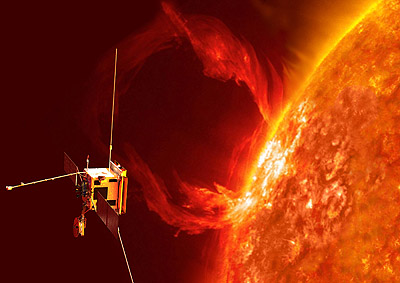
David Berghmans and Cis Verbeeck are both working at the ROB, which will do the operations management after the Solar Orbiter launch. They are looking forward to the moment when the satellite will be flying in space: 'Solar Orbiter is the most exciting solar physics mission of our career, promising to bring far-reaching advances in the understanding of our local star, the Sun. We can't be happier with the important investments Belgium is making in space research.'
During the upcoming workshop, more than 160 scientists from 17 countries all over the world will address the science questions of this exciting and challenging mission.
Solar Orbiter homepage: http://sci.esa.int/solarorbiter
Solar Orbiter Workshop 5 page: http://www.stce.be/solarorbiter5/
In one of the previous STCE Newsletters (http://stce.be/news/155/welcome.html ), a long-living and quite dynamic solar filament was discussed.
This filament was visible on the solar disk during the first two weeks of August, losing only a small part of its structure despite various eruptions. On August 14, it started its backside transit, reappearing again from behind the southeastern solar limb two weeks later. As can be seen from the GONG-images (http://halpha.nso.edu/ ) taken on 4 and 31 August, the remaining part of the filament still seemed quite solid and ready for an encore performance.
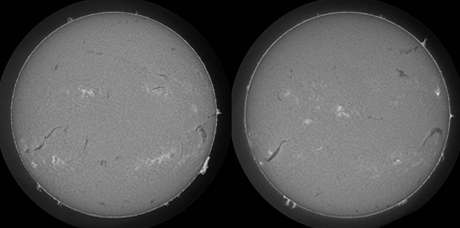
However, the magnetic fields supporting this filament were not stable anymore. Finally, during the evening hours of August 31, they forced the filament into an impressive and final eruption. A movie of this event can be seen at http://www.youtube.com/watch?v=bKz18xwPO44 It consists of 5 parts.
First comes an H-alpha clip (chromosphere) from the Big Bear Observatory (GONG - http://halpha.nso.edu/ ), showing that the filament eruption, which may have been caused by magnetic interaction with nearby, but small active region NOAA 1562, was followed by a relatively small flare. As one can see in the picture underneath (SDO-overlay on 2 GONG-images), this flare consisted of two rather large, bright, parallel regions along the inversion line where the filament used to be. Such a flare (a two-ribbon flare that is the result of a filament eruption outside sunspot groups) is usually called a Hyder-flare, after the scientist who first studied this kind of events.
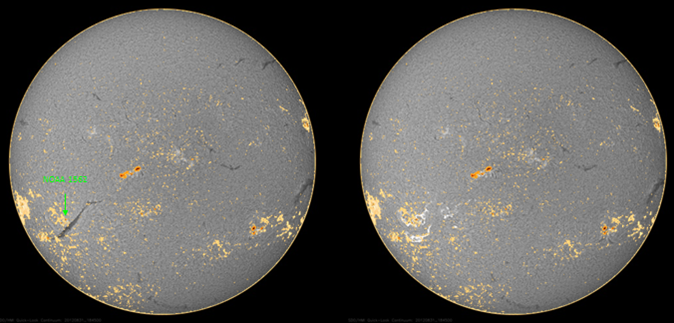
The next two parts show the eruption at increasingly hotter temperatures. SDO/AIA 304 (http://sdo.gsfc.nasa.gov/data/ ) images the event in the transition region in temperatures around 50.000 degrees. Note the movement of the dark "cloud" over the erupting area after the flare, which is "cold" material trapped in the magnetic cage of the solar atmosphere. PROBA2/SWAP (http://proba2.oma.be/swap/data/ ) shows the eruption in the hot corona (about 1 million degrees). Note the ejected material and post-flare coronal loops ("arcade").
The SDO/AIA 171 clip zooms in on the eruption and provides a detailed view of this spectacular eruption and the blast region (hot corona; around 650.000 degrees).
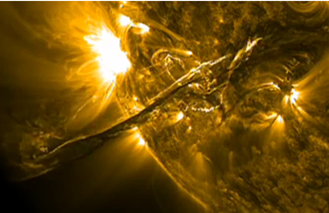
The final part consists of a combination of SDO/AIA 304 and SOHO/LASCO C3 (http://sohowww.nascom.nasa.gov/ ) imagery showing an expanding halo coronal mass ejection (dashed green ellipse in image underneath) of which the right part is directed towards Earth. The core of the erupted filament, indicated by a solid green ellipse, was directed away.
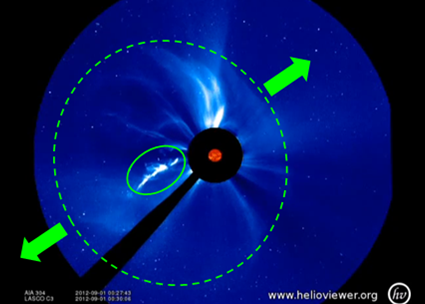
A glancing blow of this relatively slow moving particle cloud (+/- 520 km/s) struck Earth on Monday September 3, at noon, sparking a minor geomagnetic storm. Aurorae were visible in Scandinavia, Scotland, Canada and Alaska.
The highlight of this week was a filament eruption on August 31. Looking at SDO/AIA 193 imagery, one can see that the filament started to rise around 19:00UT. At 20:15UT, the filament was detached. The plasma eruption was associated with a C8.4 long duration flare, starting at 19:45UT, peaking at 20:43UT and ending at 21:51UT. It was a small proton event as well. Post eruption loops appeared at the location of the filament around 20:30UT, and remained visible until September 1, 08:00UT. Particularly interesting in this event is that the flare is not directly associated with a sunspot group. The filament was situated between NOAA AR 1563 and 1562.
The window underneath is composed of SDO/AIA 193 images made at 19:05UT, 19:47UT, 20:43UT and 23:00UT, showing the various phases of the event as described above.
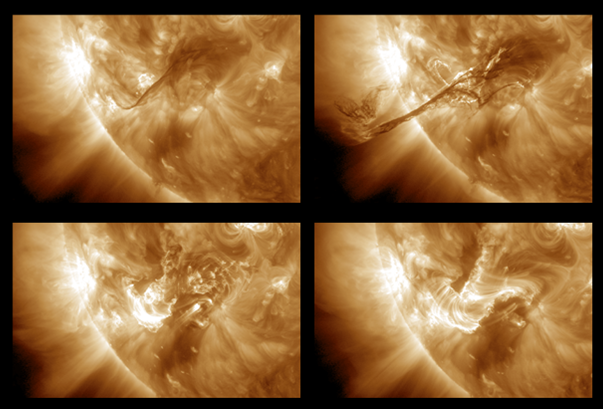
The NOAA active region 1563 produced the flare with the strongest X-ray radiation intensity of this week. It was a confined M1.3-flare on August 30, peaking at 12:11UT. There were no space weather consequences linked to this flare.
| DAY | BEGIN | MAX | END | LOC | XRAY | OP | 10CM | TYPE | Cat | NOAA | NOTE |
| 30 | 1202 | 1211 | 1214 | S27E85 | M1.3 | 0 | 67 | 1563 |
| LOC: approximate heliographic location | TYPE: radio burst type |
| XRAY: X-ray flare class | Cat: Catania sunspot group number |
| OP: optical flare class | NOAA: NOAA active region number |
| 10CM: peak 10 cm radio flux |
Solar Activity
Early this week, the Sun's activity level was *Very Low*. Solar activity started increasing to at the east limb on Tuesday, with the appearance of active regions 11563 and 11564. Many C flares of increasing level occurred (*Low*) up to the end of the week, including a single M flare on Thursday (*Moderate*). On Friday, a huge filament erupted, as the result of a C8.4 flare (see below).
In order to view the activity of this week in more detail, we suggest to go to the following website from which all the daily (normal and difference) movies can be accessed: http://proba2.oma.be/ssa.
This page also lists the recorded flaring events.
A magnificent filament eruption occurred on Friday 31st around 19:40 (see picture below; movies of the whole eruption can be found at this location: http://proba2.oma.be/swap/data/mpg/movies/campaign_movies/2012_08_31_FilamentEruption/). The erupting filament can be seen traveling in the South East direction. At the time of this image, the erupting filament is extending out of the SDO/AIA field of view.
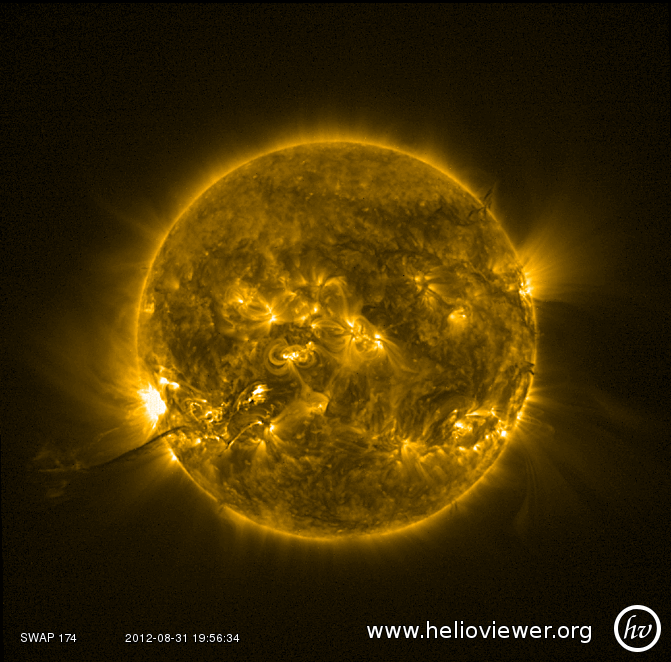
The geomagnetic conditions were very quiet until September 02. On September 01, the interplanetary
magnetic field turned to southward direction and the strength increased suddenly, while the solar wind speed stayed the same. This boundary section crossing caused unsettled to active conditions on September 2.
PROBA2 Science Days May 2012
http://www.spaceweather.eu/en/repository/show?id=242
http://www.spaceweather.eu/en/repository/show?id=243
PROBA2 Science Days May 2012
http://www.spaceweather.eu/en/repository/show?id=244
PROBA2 Science Days May 2012
http://www.spaceweather.eu/en/repository/show?id=245
PROBA2 Science Days May 2012
http://www.spaceweather.eu/en/repository/show?id=246
PROBA2 Science Days May 2012
http://www.spaceweather.eu/en/repository/show?id=247
PROBA2 Science Days May 2012
http://www.spaceweather.eu/en/repository/show?id=248
PROBA2 Science Days May 2012
http://www.spaceweather.eu/en/repository/show?id=249
PROBA2 Science Days May 2012
http://www.spaceweather.eu/en/repository/show?id=250
PROBA2 Science Days May 2012
http://www.spaceweather.eu/en/repository/show?id=251
The SALE Executive is pleased to announce that a set of high level talks on
various aspects of the energetic particle radiation hazard to aviation crews
and personnel aboard spacecraft in LEO will be presented at a meeting of the
Spacecraft, Aircraft and Launcher Environments group during Space Weather
Week in Brussels, Belgium (8 November, 2012).
Abstracts of these talks are attached and EVERYONE is cordially invited to
attend on this very special occasion.
http://www.spaceweather.eu/en/repository/show?id=252
Start : 2012-09-10 - End : 2012-09-14
The Summer school is part of the training program of the Marie
Curie Initial Training Network TRANSMIT, funded by the European
Commission. Young scientists involved in TRANSMIT shall be trained
and educated for being aware and getting basic understanding of
ionospheric threats in different fields of application. Awareness
and knowledge of ionospheric threats is the starting point of
subsequent work to reduce or mitigate them in practical
applications.
Well recognized experts in their fields will give lectures to
better understand/learn about:
* Physical nature of ionospheric perturbations at all scales
* Ionospheric impact on radio wave propagation
* Detection/Monitoring of ionospheric perturbations
* Estimation the degree of ionospheric perturbation
* Mitigation techniques for avoiding threats in technical
systems
It is expected that lectures and discussions at the summer
school will help in particular early stage researchers to improve
their scientific work.
Website:
http://www.transmit-ionosphere.net/
Start : 2012-09-10 - End : 2012-09-14
We are pleased to announce that the fifth Solar Orbiter Workshop
will take place in Brugge, Belgium from Monday September 10 to
Thursday September 13. Friday September 14 will be dedicated to a
Science Working Team (SWT) meeting. The workshop will focus on the
science questions addressed by this exciting and recently approved
mission, which is a partnership between ESA
and NASA
. The scientific synergy of Solar
Orbiter with Solar Probe Plus and other missions will also be
highlighted.
Website:
http://www.stce.be/solarorbiter5/
Start : 2012-09-17 - End : 2012-09-22
The School of Astrophysics 'Francesco Lucchin' is addressed to
PhD students in Astronomy and Physics, as well as to interested
young researchers. The school aims at providing a comprehensive
background in Astronomy and Astrophysics, from both a theoretical
and an observational point of view.
The main purpose of the school is to provide common cultural
ground on hot topics of research, both observational and
theoretical, to young astronomers. This will reveal the potential
links between the various projects in which the PhD students and
young researchers are involved, and encourage collaborative
research for the future.
The school is open to students and young researchers of all
backgrounds (experimental, observational, theoretical).
The topics of the school are:
* The Sun: a Plasma
Physics Laboratory (Chair:
Francesca Zuccarello)
* Formation of the solar system: clues from exploration (Chair:
Priscilla Cerroni)
Website:
http://www.iasf-roma.inaf.it/IAPS/AstroSchool/
Start : 2012-09-17 - End : 2012-09-26
The International Space Weather
Initiative (ISWI) is a program of
international cooperation to advance the space weather
science by a combination of
instrument deployment, analysis and interpretation of space weather
data from the deployed instruments
in conjunction with space data, and communicate the results to the
public and students. ISWI is a follow-up activity to the successful
IHY 2007, but focusing exclusively on space weather
. The goal of the ISWI is to
develop the scientific insight necessary to understand the science,
and to reconstruct and forecast near-Earth space weather
. This includes instrumentation,
data analysis, modeling, education, training, and public outreach.
ISWI has conducted many programs not only to popularise space
science all over the world but also to create favorable conditions
for joint research and training in some sort of global framework.
In the framework of IHY and ISWI, some research groups have been
established in several countries. In order to establish the strong
space research group, particularly in Asia-Oceania countries, a
training to the young students and researchers is necessary. In the
framework of this program, the Space Science Center of National
Institute of Aeronautics and Space (LAPAN) is honored to host the
2012 ISWI and MAGDAS School in Space Science, the school to young
solar physicists and geophysicists, to be held on 17-26 September
2012 in Bandung Indonesia.
Website:
http://iswimagdas2012.dirgantara-lapan.or.id/
Start : 2012-09-18 - End : 2012-09-19
The 2012 Solar Radiation and Climate Experiment (SORCE) Science
Meeting examines modeling efforts to understand solar spectral
irradiance (SSI) variability, in terms of both its origins in the
solar atmosphere and its impact on Earth's climate and atmosphere.
In solar physics, advancements in radiative transfer, surface
feature identification, dynamics and how observations of solar
magnetic fields and irradiance all lead to an improved
understanding of the mechanisms of irradiance change.
Earth-atmospheric general circulation models (GCM) incorporating
sophisticated codes for chemistry, radiation, dynamics, and
feedback mechanisms associated with clouds, aerosols, and ocean
processes are able to address the role of SSI variability in
climate. In both cases, comparisons with observations lead to a
deeper understanding of the dynamic solar atmosphere and our
complex Earth climate system.
Website:
http://lasp.colorado.edu/sorce/news/2012ScienceMeeting/
Start : 2012-09-18 - End : 2012-09-20
In-situ observations by spacecraft provide [note in no
particular order] the ground truth for comparison and constraining
models, have transformed our ideas of the heliosphere
, provide a natural laboratory for
plasma
physics, have challenged our
pre-conceived ideas, and have discovered completely unexpected
phenomena. This workshop will focus on in-situ observations of the
heliosphere
made by the unprecedented suite of
instruments currently returning observations, including the STEREO
spacecraft, near-Earth spacecraft
(ACE,WIND
, SOHO
) and the Voyager spacecraft that
are probing the region approaching the heliopause. It is a follow
on from the ACE/WIND
/STEREO
... workshop held in Kennebunkport
in June 2010. The program will include an overview of recent
results from current missions, invited presentations, and splinter
sessions with a heavy emphasis on discussion. These sessions will
focus on the solar cycle variations, solar wind
, solar energetic particles,
suprathermal ions, coronal and interplanetary transients, and
anomalous and galactic cosmic rays.
Website:
http://stereo.ssl.berkeley.edu/meetings/Sept.2012meeting/
Start : 2012-09-20 - End : 2012-09-23
Every year, the International Meteor
Organization (IMO) organizes the
International Meteor
Conference (IMC). This conference
deals with all aspects of meteor
observation as well as the
underlying physics and is aimed at both amateurs and
professionals.
The International Meteor
Organization (IMO) will hold the
31st annual International Meteor
Conference (IMC) on La Palma,
Canary Islands, Spain, from 20 till 23 September, 2012. The
conference will be organized by the Astro Travels agency in
collaboration with the Cabildo of La Palma island authority which
will sponsor this event.
Website:
http://www.imo.net/imc2012/
Start : 2012-09-24 - End : 2012-09-28
The 21st European Conference on RADIATION AND ITS EFFECTS ON
COMPONENTS AND SYSTEMS will be held in Biarritz, France, on
September 24-28, 2012.
The aim of RADECS conferences is to provide an annual European
forum for the presentation and discussion of the latest advances in
the field of radiation effects on electronic and photonic
materials, devices, circuits, sensors, and systems. The scope of
the conference encompasses technological processes and design
techniques for producing radiation tolerant systems for space,
aeronautical or terrestrial applications, as well as relevant
methodologies for their characterization and qualification. The
conference features a technical program, an Industrial Exhibit, and
one day meeting on ground effects offered on September 24
(RADGROUND). The technical program includes oral and
postersessions.
The areas of interest for contributions to be submitted to
RADECS 2012 include, but are not limited to:
* Basic mechanisms of radiation effects in electronic and
optical materials
* Space, atmospheric and terrestrial environments
* Radiation effects on electronic and photonic devices, circuits
and systems
* Radiation effects on sensors and emerging devices
* Technology and design hardening
* Radiation hardness assurance
* Irradiation facilities and testing
Website: http://radecs2012.org
Start : 2012-10-01 - End : 2012-10-05
At the forthcoming 63rd International Astronautical Congress in
Naples a special session on the theme 'Effects of Space Weather
on GEO
Satellites' will be held as part of
the 25th Symposium on Space Policy, Regulations and Economics.
This session will discuss case histories and mechanisms of
effects of space weather
on GEO
satellites, models for prediction,
and mitigation approaches. We would like to invite you to consider
submitting abstracts for this session.
The call for papers can be found at
The
deadline for abstract submission is 29 February 2012.
http://www.iafastro.org/docs/2012/iac/IAC2012_CallForPapers.
Website: http://www.iac2012.org/
Start : 2012-10-08 - End : 2012-10-12
Initiated in 1990, the United Nations Basic Space Science
Initiative (UNBSSI) has contributed to the international and
regional development of astronomy and space science through annual
workshops organized under the umbrella of the United Nations,
focusing specifically on the International Heliophysical Year 2007
(IHY, 2005-2009) and the International Space Weather
Initiative (ISWI, 2010-2012).
UNBSSI has led to the establishment of planetariums, astronomical
telescope facilities, and IHY/ISWI instrument arrays worldwide,
particularly in developing nations. ISWI is envisioned to continue
the tradition of IHY in the worldwide deployment of space weather
monitoring instrument arrays. To
date, ISWI contributes to the observation of space weather
through 18 instrument arrays with
close to 1000 operating instruments in more than 100 nations
supported by designated national ISWI coordinators.
The first workshop on ISWI was held in Helwan, Egypt and hosted
by the Helwan University, Egypt, in 2010, particularly for the
benefit of nations in Western Asia. In 2011 the United
Nations/Nigeria Workshop on ISWI was hosted by the Centre for Basic
Space Science of the University of Nigeria at Nsukka, Nigeria,
particularly for the benefit of nations in Africa. The third ISWI
workshop will be hosted by Ecuador in 2012 for the region of Latin
America and the Caribbean.
Website:
http://iswiecuador.epn.edu.ec/
Start : 2012-10-22 - End : 2012-10-24
2012 - 2013 is expected to be years with high solar activity.
This can trigger larger solar storms which can generate geomagnetic
induced currents (GIC
) on the earth. GIC
can affect the normal operation of
specific industrial operations and critical infrastructure (e.g
power grids, telecom, navigation systems, etc).
During space weather
events, like solar storms, electric
currents in the magnetosphere
and ionosphere
experience large variations, which
manifest also in the earth's magnetic field. These variations
induce currents (GIC
) in conductors operated on the
surface of the earth. Electric transmission grids and buried
pipelines are common examples of such conductor systems. GIC
can cause problems, such as
increased corrosion of pipeline steel and may disturb and possible
damaged high-voltage power transformers and it can also have
damaging effects on communication systems, navigation systems and
oil and gas operations.
Vulnerable industries are the oil and gas industry, railways,
telecommunication industry, navigation industry and not at least
the society, which is very vulnerable concerning short or long term
interruption of critical infrastructure.
The conference will focus on increasing the general knowledge of
solar storms, space weather
and GIC
and the possible consequences for
different industries and critical infrastructure, and look into
reasonable means of protection, and consider possible early warning
solutions.
Website:
http://www.tiems.info/about-tiems/oslo-conference-2012.html
Start : 2012-11-05 - End : 2012-11-09
We are pleased to announce that the Ninth European Space Weather
Week will take place at the
Académie Royale de Belgique, Brussels, Belgium between 5
and 9 November 2012.
This meeting is being jointly organised by the Solar-Terrestrial
Centre of Excellence (STCE), ESA
, the SWWT and the COST ES0803
communities. The local organisation is done by the STCE. This event
will continue to build on the advances made during the first eight
European Space Weather
Weeks held between 2004 and
2011.
Website:
http://www.sidc.be/esww9/
Start : 2012-11-06 - End : 2012-11-09
The International Symposium on Solar-Terrestrial Physics will be
held during November 6 - 9, 2012 at the Indian Institute of
Science, Education and Research, Pune, India. This meeting under
the aegis of the SCOSTEP is expected to draw leading scientists
from around the world in the increasingly important,
interdisciplinary fields of Solar activity and its impact on
geospace and life on the Earth. With major observational solar
facilities being planned in India, this meeting is especially
pertinent in the Indian context.
The meeting is expected to involve professional scientists as
well as graduate students, and will have a mixture of invited and
contributed talks and posters. There will also be a one-day
tutorial for the benefit of young people beginning work in the
field of solar-terrestrial physics.
Website:
http://www.iiserpune.ac.in/~isstp2012/
Start : 2012-11-12 - End : 2012-11-16
As we emerge from one of the deepest and longest solar minima on
record, with a new and powerful eye on the Sun -SDO- we invite all
those with an interest is solar activity to gather in beautiful
Palm Cove, Australia to review and assess our current knowledge and
understanding of our magnetic star
, and to experience the awe and
wonder of a total solar eclipse on November 14, 2012.
Website:
http://moca.monash.edu/eclipse/
Start : 2012-11-13 - End : 2012-11-13
For more information:
http://eclipse.gsfc.nasa.gov/OH/OH2012.html#SE2012Nov13T
Start : 2012-11-15 - End : 2012-11-16
The European Commission will organise the 'Let's embrace
space - FP7 Space Conference 2012', in cooperation with the Cypriot
EU Presidency, on 15 and 16 November 2012 in Larnaca, Cyprus.
This scientific conference will present the current status and
results of the 3rd call of FP7 space research, and also discuss
future options for European research in the space field. In doing
so, the conference will aim at demonstrating the evolution and use
of space tools for a sustainable economic and environmental
development in a European and global context.
Website:
http://www.fp7-space.eu/news-119.phtm
Start : 2012-11-20 - End : 2012-11-23
Nobeyama Radioheliograph (NoRH) has been observing the Sun since
1992. This year is the 20th year of science operation. Instruments
are still in good shape and producing images of the Sun every day
with the same quality as the beginning. Due to the nature of the
instrument and long and uniform observations, data can be used for
wide variety of solar physics and also for solar terrestrial
physics. To mark the 20 years of operation, we will organize a
symposium to summarize what has been done with NoRH and to discuss
what we should do in the future. Papers to be presented in the
meeting will be mainly concerned with the results from NoRH and
future plans.
Website:
http://st4a.stelab.nagoya-u.ac.jp/SPRO2012/
Start : 2012-11-30 - End : 2012-12-05
The overarching objective of the conference is to examine the
connections amongst the phenomena that lead to solar eruptive
events. The current state of themes includes:
* Measuring the Coronal Magnetic Field;
* Connections to, and Reactions of, the Large-Scale Corona;
* Large-scale Magnetic Connectivity of Active Regions;
* Transfer of Energy to, and Storage of Energy in, the
Corona;
* The High-Energy Particle - Flare - CME
connection.
Working groups will address topics such as:
* Energy Transfer throughout a Solar Eruptive Event;
* Global Energetics of an Ensemble of Events;
* Coronal Influences to the Lower Atmosphere;
* CME
Initiation and Type II Bursts;
* The Release of Energetic Particles in the Low Corona;
* Flows vs. Waves;
* Microflares/Nanoflares.
Website:
http://hessi.ssl.berkeley.edu/petaluma/index.shtml
Start : 2013-01-13 - End : 2013-01-19
Information coming soon!
Website:
http://sd-www.jhuapl.edu/Aurora/ESSE/index.html
Start : 2013-03-03 - End : 2013-03-08
Living With a Star
's Solar Dynamics Observatory
invites you to its 2013 Science Workshop to be held March 3-8, 2013
at the Hyatt Regency Chesapeake Bay in Cambridge, MD
(http://chesapeakebay.hyatt.com/). The workshop is a follow-on to
the 'Many Spectra of Solar Activity' workshop held May 1-5, 2011 in
Squaw Valley, CA.
Scientific sessions will feature a broad spectrum of science
topics fundamental to SDO's science investigations:
Atmospheric Imaging Assembly (AIA), EUV Variability Experiment
(EVE), and Helioseismic and Magnetic Imager (HMI), as well as the
overlap between SDO and other scientific missions and
activities.
Website:
http://lws-sdo-workshops.org/
Start : 2013-03-10 - End : 2013-03-15
Spacecraft observations have established that all magnetized
planets in our solar system interact strongly with the solar wind
and possess well-developed
magnetotails. Magnetotails are the site for many dynamic processes
critical to the circulation of mass, energy and magnetic flux. The
great differences in solar wind
conditions, planetary rotation
rates, ionospheric conductivity, and physical dimensions from
Mercury's small magnetosphere
to the giant magnetospheres of
Jupiter and Saturn provide an outstanding opportunity to extend our
understanding of the influence of these factors. Therefore, this
Chapman conference will provide a forum in which various
communities can come together and discuss recent achievements of
observational, theoretical, and modeling studies with the objective
to develop a deeper understanding of fundamental properties and
processes of planetary magnetotails through a comparative
examination.
Start : 2013-05-10 - End : 2013-05-10
For more information:
http://eclipse.gsfc.nasa.gov/SEplot/SEplot2001/SE2013May10A.GIF
Start : 2013-06-10 - End : 2013-06-16
Topics:
* Prominences : formation, dynamics
* Prominence plasma properties, including prominence
seismology
* Magnetic field : measurements, topology, support
* Large-scale patterns and cyclic evolution
* Prominence destabilization, CMEs, reconstruction in 3D
* ICMEs in the heliosphere, magnetic clouds; their impact on the
Earth environment
* Stellar quiescent and eruptive prominences and stellar CME
* Requirements for future instrumentation and prospects for
future missions
Website:
http://www.iau.org/science/meetings/future/symposia/1065/
Start : 2013-06-24 - End : 2013-06-29
Solar cycle 24 has opened a new era in solar radio physics as we
now have instruments that can probe solar processes from
sub-millimeter to kilometer waves. ALMA and LOFAR are entering
full-operation state and observations of the Sun will be made in
the near future.
At the same time extensive use is being made of radio
spectrometers in space, STEREO
/WAVES and Wind
-WAVES, and existing and upgraded
ground-based instruments like Nobeyama Radioheliograph, Nancay
Radioheliograph, Ratan, SSRT, and many others. These instruments
provide data that enable studies of both energetic particles and
thermal plasma
, enhancing our knowledge of solar
eruptions and acceleration and propagation of particles, all
through the solar chromosphere
and corona and into interplanetary
space.
The CESRA 2013 Workshop will highlight these new observational
capabilities and discuss the theoretical issues connected to solar
radio emission and interplanetary radio physics.
Website:
http://wave.asu.cas.cz/cesra2013/
Start : 2013-07-08 - End : 2013-07-11
The 2013 meeting of the AAS/SPD will be July 8-11 (and possibly
July 12), hosted by the Solar Physics Group of Montana State
University, in Bozeman, Montana.
Website:
http://solar.physics.montana.edu/SPD/
Start : 2013-11-03 - End : 2013-11-03
For more information:
http://eclipse.gsfc.nasa.gov/SEplot/SEplot2001/SE2013Nov03H.GIF